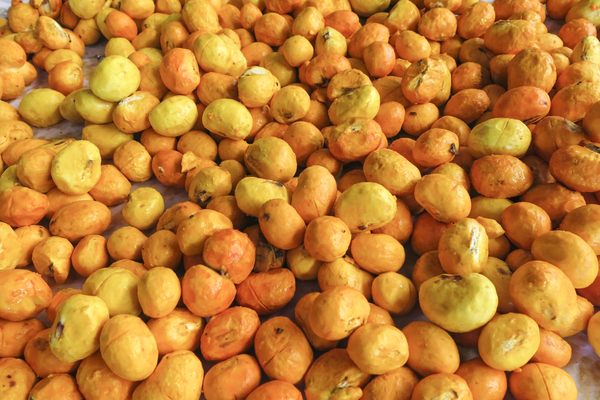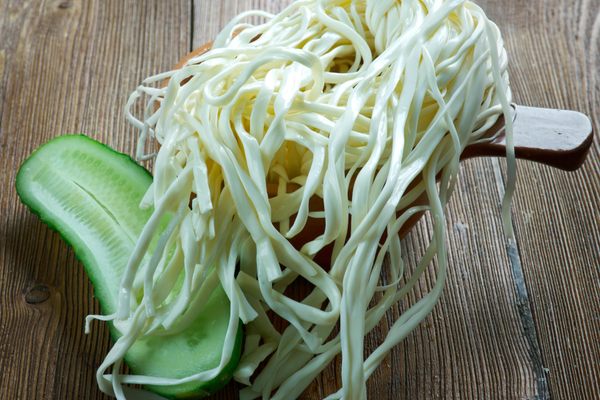Meats & Animal Products
Canastra Cheese
This traditional Brazilian raw milk cheese is caught in the crosshairs of a battle over government regulation.
In 2012, news of a major smuggling ring broke in Brazil. The contraband? Cheese, and specifically queijo Canastra, a famous raw-milk cheese of the southeastern state of Minas Gerais. Cheesemakers from Minas Gerais have been making some of Brazil’s most delicious cheese for more than 200 years. In the past couple years, the Brazilian government has recognized Canastra cheese as a piece of intangible cultural heritage, and producers have earned top honors at French cheese festivals. But restrictive food safety regulations in Brazil, which mandate industrial-level production standards for artisanal cheesemakers and prohibit the sale of raw milk cheese across state lines, continue to stifle small-scale producers.
Canastra is made in the Serra da Canastra region of Minas Gerais. When Portuguese colonists first reached the area, the mountainous terrain reminded them of their home country’s Serra da Estrela cheesemaking region, which is famous for an eponymous cheese. The Portuguese brought their cheesemaking traditions to the region, and over more than two centuries, local producers built on this knowledge to develop a distinctive Canastra cheese.
To make the cheese, producers mix rennet and pingo, the previous day’s whey, into a vat of raw milk, then drain the whey from the resulting mixture and pour the paste into round molds to mature. Producers press the paste together by hand, then cover the compacted discs with salt for curing. After a few days, the cheese is placed on a shelf to age. After the usual 21-day aging period, the finished cheese is medium-soft, with a buttery mouthfeel. It has a golden rind that, once cut through, yields a creamy, yellow-white center as well as an aroma and slightly sharp flavor that reflects the local grasses and oats the cows eat. It’s delicious alone or in the traditional pão de queijo, Brazilian cheese bread.
While the Brazilian government has recognized queijo Canastra as culturally important, tensions over the regulation of the industry remain. Most of the cheesemakers in Minas Gerais are small-scale and artisanal, often individual families without the financial resources to meet stringent government production requirements. But national food safety regulations make no distinction between these family-run endeavors and bigger, industrial cheesemakers, and disallow raw milk cheese. As a result, many Canastra producers don’t have Federal Inspection Service seals and therefore aren’t allowed to sell outside of Minas Gerais. Cheese lovers bemoaned the tragic results of these regulations during the 2017 Rock in Rio music festival, when the Brazilian government destroyed the artisanal cheese a chef had intended to serve to festival diners due to lack of the proper license.
Recently, cheesemakers in Minas Gerais have begun to organize into local associations, as part of a movement to legalize traditional raw milk cheese. With any luck, they’ll get the legal recognition a 200-year-old cheesemaking tradition has doubtlessly earned—and the need to smuggle cheese will be gone for good.
Written By
 Reina Gattuso
Reina Gattuso
Sources
- www.slowfood.com/contraband-cheese/
- www.fondazioneslowfood.com/en/ark-of-taste-slow-food/queijo-canastra-artesanal-2/
- www.notyourmotherscookbook.com/the-culinary-traveler-pao-de-queijo-brazilian-cheese-bread/
- books.google.com/books?id=clSSDwAAQBAJ&pg=PA172&lpg=PA172&dq=serra+da+estrela+canastra+cheese&source=bl&ots=cL6n02FwJr&sig=ACfU3U0ZXQhnov3SxhovV71CZf2xYB9OzA&hl=en&sa=X&ved=2ahUKEwjEnJ2v0ILjAhWur1kKHSe1B2wQ6AEwD3oECAkQAQ#v=onepage&q=serra%20da%20estrela%20canastra%20cheese&f=false
- www.terramadre.info/en/food-communities/serra-da-canastra-cheesemakers/
















